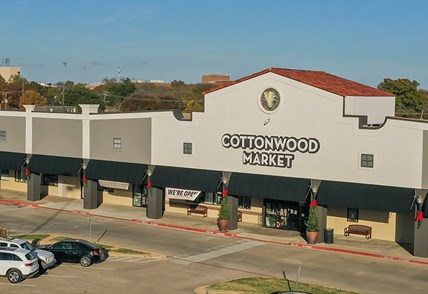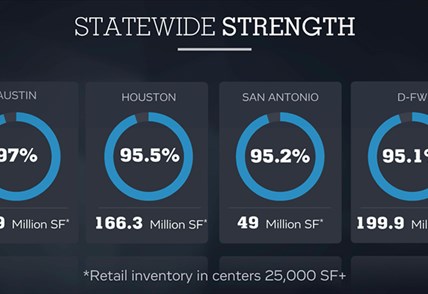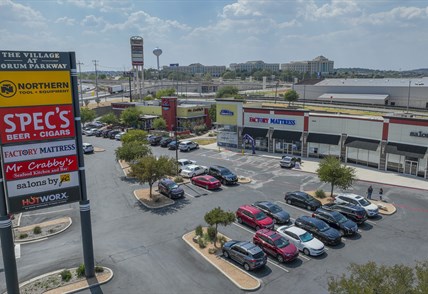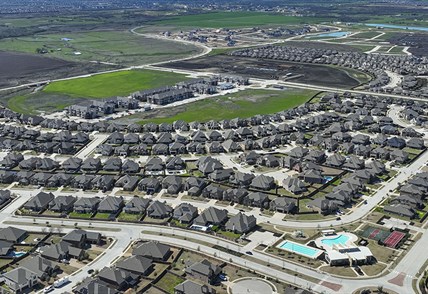San Antonio’s retail market as of year-end 2018 maintained a healthy occupancy rate of 94.0 percent, which ranks among the highest recorded for the market. However, multiple anchor closings, including those from failed or struggling legacy retailers like Toys “R” Us and Sears, resulted in an overall increase in marketwide vacancy.
The vacancy created by the closed stores was partly offset by continued small- and large-format tenants that are absorbing existing vacancies in a market with extremely scarce new-space options and limited new construction that comes online basically fully occupied. As a result, the majority of Class A and B+ centers report occupancies of 95 percent or higher, with small-shop spaces of 1,000 to 3,000 square feet particularly in short supply.
NEW SPACE REACHES RECORD LOWS
In terms of new space, San Antonio in 2018 reported one of its lowest annual construction totals ever. While several major retail centers are under construction or in the works, they are not scheduled for completion until 2019 or later.
All told, only about 275,000 square feet of new retail space – not even a 1 percent addition to the market’s total inventory – opened during 2018 in new and expanded projects.
For 2018, the largest projects involved entertainment and large-format single-focus retail. The largest new retail projects scheduled for 2018 are detailed in Appendix D.
The market’s previous construction low point was 301,000 square feet added during the recessionary year of 2011. The 2018 total also came in below retail construction of 360,000 square feet in 2017, another year of extremely conservative construction, especially for a market with high occupancy and a healthy overall economy.
EXISTING CENTER LEASING REDUCES VACANCY
The market is well positioned to absorb any additional vacancy due to the above-mentioned lack of major new construction at a time when retail demand remains in the healthy range and the strongest intersections report a lack of available space.
STORE CLOSINGS IMPACT OCCUPANCY, BUT OUTLOOK IS POSITIVE FOR SPACES TO BE BACKFILLED OR REDEVELOPED
The pace of closings during 2018 did not approach what the market experienced during the financial crisis and subsequent recession in 2008-2010, but it does represent the largest number of closings in a single year since that period, as well as a gross increase in vacancy of more than 2 percent. Strong leasing during the year, as well as well-leased new space coming onto the market, helped reduce the net increase in vacancy.
Store closings during 2018 include a decades-old, 145,000-square-foot Sam’s Club at 12919 San Pedro; a Target store at Woodlake Crossing, at 7914 W. FM 78; Walmart Neighborhood Market, which closed three of the market’s small-format Walmart stores (leaving it with six in the market) that together totaled slightly more than 120,000 square feet; four local Toys “R” Us and/or Babies “R” Us stores, which created about 220,000 square feet of anchor vacancy; and Sears, which closed a 214,000-square-foot Sears at Park North and a 150,000-square-foot store at Ingram Park Mall.
PAST DECADE ONE OF NOTABLE GAINS FOR S.A. RETAIL MARKET
San Antonio’s retail market has improved its performance and overall strength during the past decade, largely thanks to conservative construction, steady leasing and a healthy metro economy.
In 2008, the Alamo City reported a retail market inventory of 35.6 million square feet. The occupancy rate was 91.5 percent, which was in the healthy range. During 2008, new space added to the market totaled 3.6 million square feet in major projects including The Shops at La Cantera, Alamo Ranch and a new power-retail phase at The Rim.
A decade later, in 2018, the market’s retail inventory totals 46.1 million square feet. New construction over the past decade has averaged slightly more than 1 million square feet annually, and that demand-based construction has resulted in a larger market with stronger occupancy: 46.1 million square feet and 94.0 percent occupancy today versus 35.6 million square feet and 91.5 percent a decade ago.
So despite the significant inventory increase, as well as the 2018 store closings, today’s occupancy is notably higher than 10 years ago. One reason is that tenancy and demand are more in line with construction and inventory.
The low construction environment drives demand to existing retail projects. This is a key reason we expect to see the market maintain healthy occupancy, even in the face of some high-profile closings.




